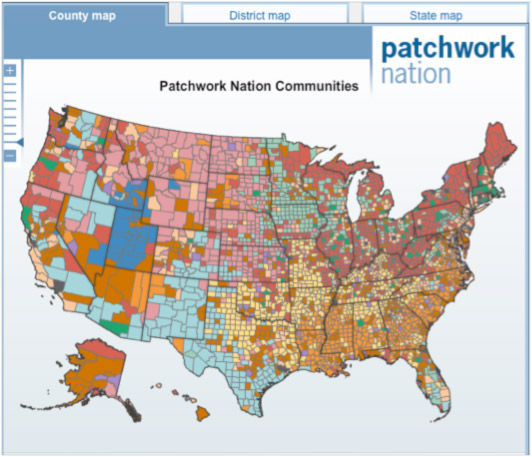by Jordan Bainer
The book Our Patchwork Nation: The Surprising Truth About the “Real” America has piqued my interest regarding how to better define consumer targets across the United States. Media tends to define states and even entire country regions by either red or blue, alluding to the different political party designations.
As with many elements of sociology, the answers are not black and white but very different shades of grey. Red and blue do not address the many idiosyncrasies that make up U.S. citizen behavior and viewpoints across the nation. Using 12 different archetypes, the authors of Patchwork Nation explain these various community types and match them up to counties across the nation using demographic, economic, and sociological factors. Though still rudimentary (as 12 community types only widens the explanation so far), it’s a compelling method of analyzing our nation.
While reading Patchwork Nation, it made me think that these community definitions would have a huge impact on how we market to certain demographic groups – in this case, affluent individuals. Assuming that an affluent consumer is going to have the same motivations and concerns across the nation would be a very black and white approach. Using Patchwork Nation’s 12 community types, below is a summary of a few key affluent motivations and concerns for each community. Though we don’t have any specific market research backing up these hypotheses, conducting a similar exercise may be a good starting point when considering communicating to “affluents” across the nation.
| Community Type | Definition | Potential Affluent Motivation(s) |
Potential Affluent Concern(s) |
| Boom Towns | Fast growing communities with rapidly diversifying populations | Building a Stable Community | Housing Equity Slumps |
| Campus and Careers | Cities and towns with young, educated populations | Supporting the Nearby Higher Education Institutions; Increased Private and Public Investment Into Local Institutions | Major Shifts in Enrollment; Drops in Community Investment |
| Emptying Nests | Home to many retirees and aging baby boomer populations | Enjoying Life’s Simple Pleasures | Dips in 401(k)’s, Long-term Investments, and Retirement Funds |
| Evangelical Epicenters | Communities with a high proportion of evangelical Christians | Supporting One’s Specific Congregation; Maintaining “Family Values” in Community and Larger Nation | Larger Social Changes that Affect Community; Maintaining Community Voice in National Politics |
| Immigration Nation | Communities with large Latino populations and lower-than-average incomes | Supporting Programs and Employment that Creates Cultural Balance | Stability of Community; Property Value Slumps; Immigration Reform |
| Industrial Metropolis | Densely populated, highly diverse urban centers | Keeping (and Improving) One’s Standard of Living; Supporting Poverty and Education Programs | Loss of Major Industrial Industries; Property Value Slumps; Education Reform |
| Military Bastions | Areas with high employment in the military or related to the presence of the military and large veteran populations | Supporting and Keeping the Nearby Military Communities and Bases | Major Changes in Military Deployment; Relocation of Nearby Military Population |
| Minority Central | Home to large pockets of African American residents but a below average percentage of Hispanics and Asians | Supporting Programs that Create Greater Employment Equality | Stability of Community; Property Value Slumps; Education Reform |
| Monied ‘Burbs | Wealthier, highly-educated communities with a median household income $15,000 above the national county average | Keeping (and Improving) One’s Standard of Living | Stock Market Dips |
| Mormon Outposts | Home to a large share of members of the Church of Jesus Christ of Latter-Day Saints | Supporting the Greater Mormon Community; Giving Financial Support to the Church | Larger Social Changes that Affect Community; Balancing Individual Success with Success of the Community |
| Service Worker Centers | Midsize and small towns with economies fueled by hotels, stores, and restaurants | Attracting More Tourist Attention and Diversifying the Population | Small Business Closings |
| Tractor Country | Mostly rural and remote smaller towns with older populations and large agricultural sectors |
Maintaining a Strong, Self-Reliant Community | Increasing Global Competition in Agriculture |
These summaries of affluent motivations and barriers are made on assumptions and are a bit oversimplified. Also, these summaries tend to be focused on community matters versus individual matters. Overall, the main point of the above grid is to illustrate that consumer segments can’t be easily blanketed across the nation. The communities that consumers live in will have a large impact on the decisions they make. I recommend reading Patchwork Nation; it might make you rethink your nationwide communication strategies and encourage further geo-market research before any major marketing push.
Sources: http://www.patchworknation.org/
Our Patchwork Nation: The Surprising Truth About the “Real” America; Dante Chinni and James Gimpel; Published by Gotham Books; Copyright 2010
![cat[&]tonic](https://cat-tonic.com/wp-content/uploads/candt_logo-rw.png)




